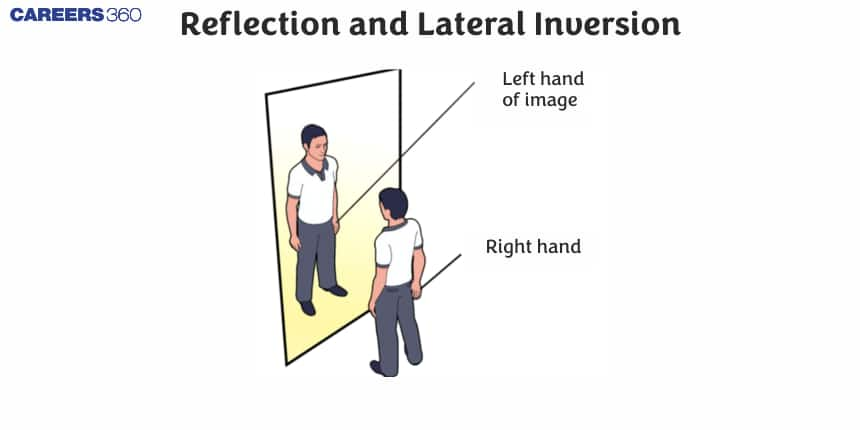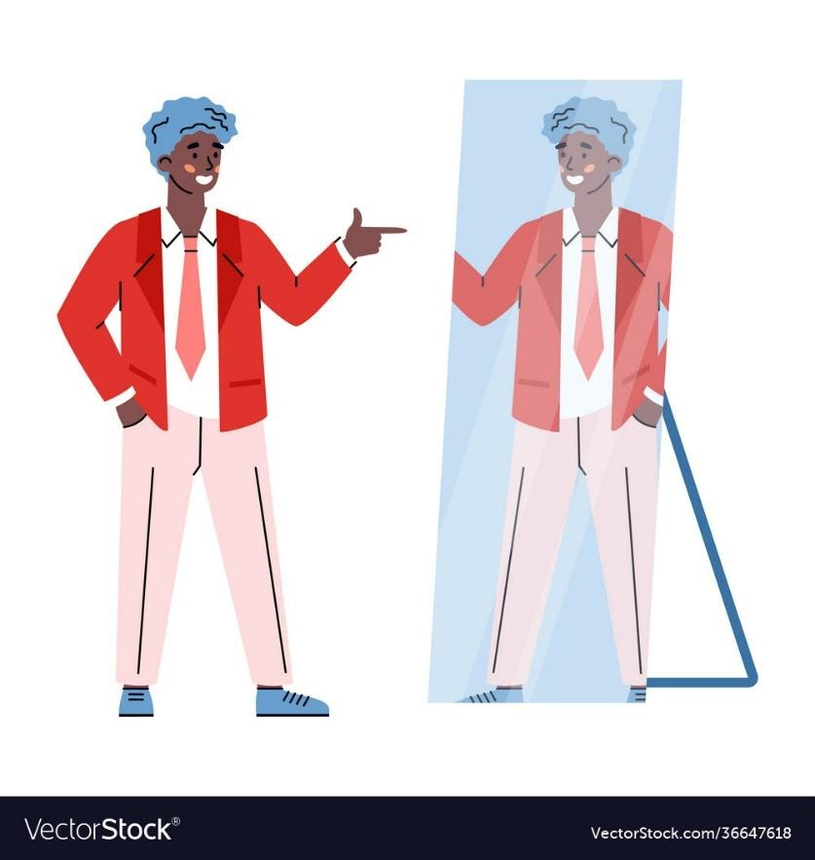Reflection and Lateral Inversion
Reflection and Lateral Inversion - The Mirror reflections appear almost identical to the original object but are reversible with respect to the mirror surface. Reflection off from a mirror or water, for example, is what causes this optical effect.
Have you ever seen your reflection or observed a lateral inversion on a lake when the surface was still enough? You certainly live with mirrors around you. Why can we see ourselves reflected on some surfaces, but not others? A surface that strikes light changes the direction it travels when it reflects it.

Also read -
- NCERT Solutions for Class 11 Physics
- NCERT Solutions for Class 12 Physics
- NCERT Solutions for All Subjects
When light hits a surface, it changes its direction, regardless of the type or texture of the surface. The difference is that a glossy surface like a shiny spoon, plate, or mirror produces a uniform reflection which results in a crisp reflection.
Mirrors are the most common way to see our reflections. When you move in front of a mirror, it appears straightforward to reflect light. An image takes on a new character when you move around. The mirror image of your right hand moves when you move your left hand. The mirror image moves its left foot when you shake your right foot. So, mirrors reverse left and right but not top and bottom?

As a starting point, let's analyze the mirror's image. A mirror shows you your reflection when you stand in front of it. Located on the right side of the mirror, this reflection is oriented correctly, since the top of your body represents the top of the mirror image.
Neither your head nor your feet point away from you. It is referred to as Lateral Inversion when the left image becomes the right image in a mirror, and vice versa. In the same way, writing a word like 'MIRROR' on paper and holding it up to the mirror has the exact same effect. Put a word on paper in front of the mirror and look at it.
What do you see in the mirror when you look at the paper that you wrote on? There is a misrepresentation of the word 'mirror' in the text. It's very confusing how a mirror reverses only the left-right direction. I'll tell you what I mean.
|
Related Topics, |
We experience lateral inversion not because of the mirror, but because of how we perceive its reflection. Take a look at the mirror image. To help illustrate, suppose that your left hand points toward the east your right hand points towards the west, and that your nose points toward the north, and the back of your head points south. If you look at the mirror image carefully, you will see that your arms, nose, and head are all pointing in the same direction, e.g., your left hand is still pointing East, your right hand is pointing West, and so on. We see it as the cause of lateral inversion. When you see a mirror image, your brain attempts to comprehend it. This causes the image to imagine that another you stood behind the mirror and walked up to you.
Even though your arms are facing the right direction, your nose, which was originally pointed toward the north of the screen, has now moved to the back and is facing the opposite way, namely the south. In other words, mirrors do not reverse left to right, contrary to how we see them. A reversed front and back are used instead. Basically, where your back should be is between your chin and cheek, and your brain interprets this as you being in front of someone else, i.e., the lateral inversion.

Letters also exhibit this effect. You can see the lateral inversion of letters more clearly. The word inverted is also inverted forwards and backward when you read it from the mirror. You will still be able to recognize the letters if you write the lateral inversed word on a piece of paper and view it from behind, even though it will still be in reverse, as it is a mirror image.
A lateral inversion is caused when the front and back are reversed.
Also, check-
- NCERT Exemplar Class 11th Physics Solutions
- NCERT Exemplar Class 12th Physics Solutions
- NCERT Exemplar Solutions for All Subjects
NCERT Physics Notes:
Frequently Asked Questions (FAQs)
Due to how we perceive the mirror image, we perceive the left and right as reversed (lateral inversion). It is referred to as Lateral Inversion when the left image becomes the right image in a mirror, and vice versa.
Latitudinally inverted images are known as lateral inversions. Due to the fact that the image of an object in a plane mirror lies both as far behind the mirror as the object is in front of it, a lateral inversion occurs due to them facing each other.
From the object, light rays are reflected on the plane mirror, reaching the eyes. It appears to our brain at this point that the reflected ray comes from within the mirror. It appears that the object is literally inverted for this reason.
Using a plane mirror, lateral inversion reverses the images left to right. A plane mirror allows us to observe our images in order to determine our left side is to the right of the image and our right side is to the left of the image.
1) Ambulances have the word AMBULANCE inverted left-right on the side so that the driver of a vehicle in the front viewing the back-view mirror can immediately recognize the word AMBULANCE while giving way.
2) A mirror can also be used to form an image.
3) someone can see the image in your eyes if they look at your lateral inversion
Also Read
05 Feb'25 04:41 PM
30 Nov'24 01:19 PM
29 Nov'24 05:26 PM
29 Nov'24 02:40 PM
29 Nov'24 01:21 PM
28 Nov'24 04:42 PM
28 Nov'24 01:26 PM
28 Nov'24 01:21 PM
26 Nov'24 03:50 PM
22 Nov'24 01:31 PM